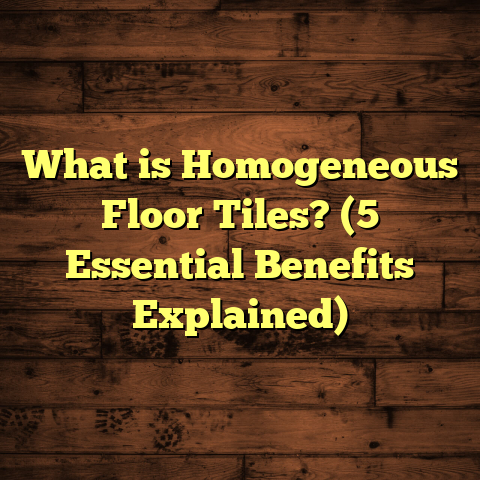What is Solarium Flooring? (5 Benefits for Your Sunroom Design)
Sustainability has become a major part of how I approach every project, especially when it comes to flooring. It’s not just about picking something that looks good; it’s about making choices that last, reduce waste, and minimize environmental impact. Flooring in a sunroom—or solarium as some call it—provides an interesting challenge because these spaces are flooded with natural light and often exposed to fluctuating temperatures and moisture. Over time, I’ve specialized in solarium flooring because it combines my passion for sustainability with practical design solutions that homeowners really appreciate.
What is Solarium Flooring?
Solarium flooring refers to floor materials and installation techniques specifically designed for sunrooms or glass-enclosed patios that allow abundant sunlight. These floors must tackle unique challenges that standard interior flooring might not face. Intense UV exposure, temperature swings, and even occasional moisture from condensation call for materials that are durable, comfortable, and resistant to warping or fading.
When I first started working on sunroom projects, I quickly realized that many traditional flooring materials like hardwood or carpet didn’t hold up well under these conditions. Floors would discolor, swell, or become brittle within a few years. So, solarium flooring isn’t just about aesthetics; it’s about selecting the right materials and finishes that can thrive in bright, sun-exposed spaces while staying comfortable and safe.
In my experience, the best solarium floors rely on a combination of durability, UV resistance, moisture management, comfort, and style versatility. Materials such as porcelain tile, cork, luxury vinyl plank (LVP), bamboo, and engineered wood—especially those treated with UV-protective coatings—are some of my top recommendations. Each has pros and cons depending on your climate, use case, and design preferences.
Why Focus on Flooring for Your Sunroom?
You might be wondering why flooring deserves such focus in a sunroom. After all, isn’t the view and the natural light what matters most? While those are important, the floor acts as the foundation of the space and significantly affects comfort, maintenance needs, energy efficiency, and overall longevity of your investment.
From my personal experience installing floors in dozens of sunrooms over the past decade, I’ve seen floors fail prematurely when the wrong materials were chosen. Homeowners got frustrated with fading colors, warped planks, slippery surfaces from condensation, and high cleaning demands.
On the other hand, when floors are selected with the solarium environment in mind, they become a part of what makes the room enjoyable year-round. You get a space that feels inviting barefoot on cold mornings and stays cool on hot afternoons. Plus, you avoid costly repairs or replacements down the line.
I’m going to walk you through five key benefits of solarium flooring based on what I’ve seen firsthand—plus some tips and advice to help you make the best choice for your sunroom.
1. Durability Against Sun Damage
Sunlight is both a blessing and a challenge for any sunroom floor. The UV rays can cause many traditional flooring materials to fade, discolor, or degrade over time. One of the biggest mistakes I see homeowners make is choosing hardwood floors for their sunroom without considering UV protection.
Personal Insight
I had a client who installed traditional oak hardwood in their sunroom without any special finish. Within two years, the floor had noticeable fading near windows and slight cracking due to drying out from constant sun exposure. It was heartbreaking because the room looked beautiful originally but lost its charm fast.
That experience taught me to always recommend materials with built-in UV resistance or those that can be treated with protective coatings. Porcelain tiles are excellent for this reason—they’re incredibly durable and show almost no color change even after years in direct sunlight.
Data-Backed Information
According to research by the Tile Council of North America (TCNA), porcelain tiles have less than 0.5% color change after prolonged exposure to UV light. This makes them ideal for spaces flooded with sunlight like sunrooms or solariums.
Engineered woods with UV-stabilized finishes also perform better than raw hardwoods. These finishes protect wood fibers from breaking down under ultraviolet rays while maintaining natural wood grain beauty.
Practical Tips
- Ask your supplier or contractor if the material includes UV protection.
- For hardwoods or engineered wood, request UV-blocking finishes or sealants.
- Avoid untreated softwoods that tend to fade quickly.
- Consider porcelain or ceramic tiles if you want a zero-fade guarantee.
- Look for warranty coverage related to sun exposure damage.
2. Temperature Regulation and Comfort
Sunrooms often experience wide temperature swings—hot during the day and cooler at night or during winter months. The type of flooring you choose plays a big role in how comfortable the room feels throughout these changes.
My Experience with Cork Flooring
One of my favorite materials for sunrooms is cork. It naturally insulates against heat loss and provides a soft surface that feels great underfoot in bare feet or socks. I installed cork flooring for a client in Portland who wanted an eco-friendly option that would keep her sunroom cozy during chilly mornings without cranking up the heater.
She told me months later that she loved how warm her feet stayed in winter and how the floor didn’t get too hot even on sunny summer afternoons. Cork’s cellular structure traps air pockets which slow heat transfer—perfect for maintaining comfort in fluctuating temperatures.
Scientific Data
Cork has a thermal conductivity rate of approximately 0.04 W/mK compared to hardwood’s 0.17 W/mK (Journal of Materials Science). Lower thermal conductivity means cork resists heat flow better, keeping your room warmer in winter and cooler in summer.
Additional Tips
- Use rugs or mats strategically in areas prone to cold drafts.
- Consider radiant floor heating under tile or stone to add warmth.
- Avoid metal-based or highly conductive flooring materials without insulation.
- Check local climate data before choosing floors; some options better suit hot-humid vs cold-dry climates.
- Underlayment can improve insulation even further for certain flooring types.
3. Moisture Resistance
Condensation often collects on windows in solariums due to temperature differences between inside warm air and outside cooler glass surfaces. This moisture can seep onto floors causing swelling, warping, mold growth, or slipping hazards if the floor absorbs water easily.
Why Vinyl Plank Flooring Stands Out
Vinyl plank flooring has been a lifesaver for many of my clients dealing with moisture issues in their sunrooms. It’s completely waterproof and easy to clean if condensation pools occasionally.
One family I worked with in Florida had persistent mold problems under their previous carpeted floor in their solarium because of high humidity levels. Switching to waterproof LVP solved this problem completely—they reported no more odors or mold growth after installation.
Industry Insight
The Resilient Floor Covering Institute (RFCI) states that vinyl floors can tolerate up to 100% moisture exposure without damage. This makes them ideal for sunrooms where humidity levels can spike unexpectedly.
How I Advise Clients on Moisture Management
- Avoid carpets or untreated woods prone to water damage.
- Choose waterproof materials like vinyl plank or sealed porcelain tile.
- Install moisture barriers under flooring if possible.
- Maintain proper ventilation to reduce condensation buildup.
- Use dehumidifiers during humid seasons.
- Opt for textured surfaces to reduce slipping risks when wet.
4. Aesthetic Versatility
One thing I love about modern solarium flooring options is how versatile they are aesthetically. You don’t have to settle for utilitarian looks just because you want durability.
My Favorite Design Stories
I helped a couple design their Mediterranean-style solarium using wood-look porcelain tiles arranged in a herringbone pattern paired with colorful mosaic accents along edges. The floor looked stunning yet held up perfectly under intense sunlight without fading or cracking.
Another client wanted a sleek contemporary vibe with minimal upkeep so we chose luxury vinyl planks mimicking reclaimed barn wood—complete with knots and grain patterns—all while providing waterproof durability.
Variety in Today’s Market
- Porcelain tiles come in countless colors, textures (matte/glossy), and patterns.
- Cork can be stained or painted in different hues.
- Luxury vinyl plank offers realistic textures from wood grain to stone.
- Bamboo flooring brings warm tones with an eco-friendly backstory.
- Engineered wood combines real wood surface with stable cores for durability.
This blend of style options means you can create sunrooms from rustic retreats to modern lounges without compromising function.
5. Low Maintenance
A big selling point for many homeowners is how easy solarium floors are to keep looking fresh despite foot traffic from indoor/outdoor use and dust accumulation from open windows.
What Works Best From My Experience
Floors like sealed concrete or vinyl plank only need occasional sweeping and mopping to stay clean and attractive. This saves time compared to carpets which trap dirt or hardwoods requiring refinishing regularly after sun damage.
One client told me she loved her vinyl plank floor because it handled muddy shoes easily after gardening sessions without staining or scratching—something her previous carpet never survived.
Maintenance Tips I Always Share
- Use area rugs at entrances to reduce dirt tracked inside.
- Clean spills immediately to avoid staining.
- Sweep regularly using soft bristle brooms or vacuum attachments suited for hard floors.
- Avoid harsh chemicals; stick to manufacturer-recommended cleaners.
- Reapply sealants on natural stone or wood floors as needed.
- Inspect grout lines on tiled floors yearly for cracks or mold buildup.
Putting It All Together: Choosing Your Solarium Floor
Choosing the right solarium flooring means balancing style preferences against climate realities and lifestyle needs. Here’s a quick checklist I recommend:
| Factor | Best Flooring Options | Notes |
|---|---|---|
| Sunlight Exposure & UV Resistance | Porcelain tile, Engineered wood with UV finish | Porcelain tiles have minimal color fade |
| Temperature Regulation | Cork, Bamboo | Natural insulators feel warm underfoot |
| Moisture Resistance | Vinyl plank (LVP), Sealed tile | Waterproof options prevent warping |
| Style Flexibility | Porcelain tile, LVP, Engineered wood | Variety of textures & colors |
| Maintenance Ease | Vinyl plank, Sealed concrete | Simple cleaning & durability |
Case Study: The Coastal Sunroom Project
Let me share a detailed case study from a project I recently completed on the coast of Maine—a place known for cold winters but bright summers.
The homeowners wanted a sunroom that could handle harsh seasonal shifts but still feel relaxing year-round. After assessing their needs:
- We chose bamboo flooring treated with UV-blocking oil finish for warmth and sustainability.
- Installed radiant heating underneath tiles near doors for extra comfort.
- Added moisture barriers below to manage condensation issues.
- Selected furniture and décor complementing natural wood tones.
After one year, they reported:
- Minimal fading despite intense summer sun.
- Warm feet during early spring mornings without cranking heat.
- Easy cleanup after sandy beach days.
- No signs of moisture damage or mold.
This project reaffirmed how thoughtful material selection combined with proper installation makes all the difference.
Dealing With Common Solarium Flooring Challenges
No matter what material you pick, some challenges can pop up:
Fading & Discoloration
Solution: Use UV-protective finishes; consider window films or blinds if sunlight is overwhelming.
Warping & Buckling
Solution: Leave expansion gaps; use engineered woods designed for fluctuating humidity; avoid solid hardwoods without acclimation periods.
Slippery Surfaces
Solution: Select textured tiles or slip-resistant vinyl; use area rugs; keep floors dry.
Mold & Mildew
Solution: Ensure proper ventilation; install moisture barriers; choose waterproof flooring options.
Final Thoughts From My Experience
Working on solarium flooring projects over the years has taught me that no single material fits all situations perfectly. Each space demands careful consideration of factors like sunlight intensity, climate zone, moisture levels, usage patterns, and design goals.
What excites me most is how technology improvements continuously expand choices—from high-performance UV finishes to realistic luxury vinyl textures—that let homeowners create beautiful sunrooms built to last sustainably.
If you’re planning your sunroom floor right now:
- Measure twice before ordering materials.
- Consult professionals experienced with solariums.
- Don’t skimp on quality—your floor is an investment meant to endure.
- Think beyond looks: consider comfort, maintenance ease, energy savings.
- Take your time exploring samples under your room’s lighting conditions.
The perfect solarium floor will deliver warmth on cold days, coolness on hot ones, resist wear from sunlight and moisture—and look amazing doing it.
If you want me to help you figure out what works best for your specific sunroom design or share more stories from the field, just ask! I’m always happy to talk shop about floors that bring sunshine into homes while standing strong through years of seasons.





